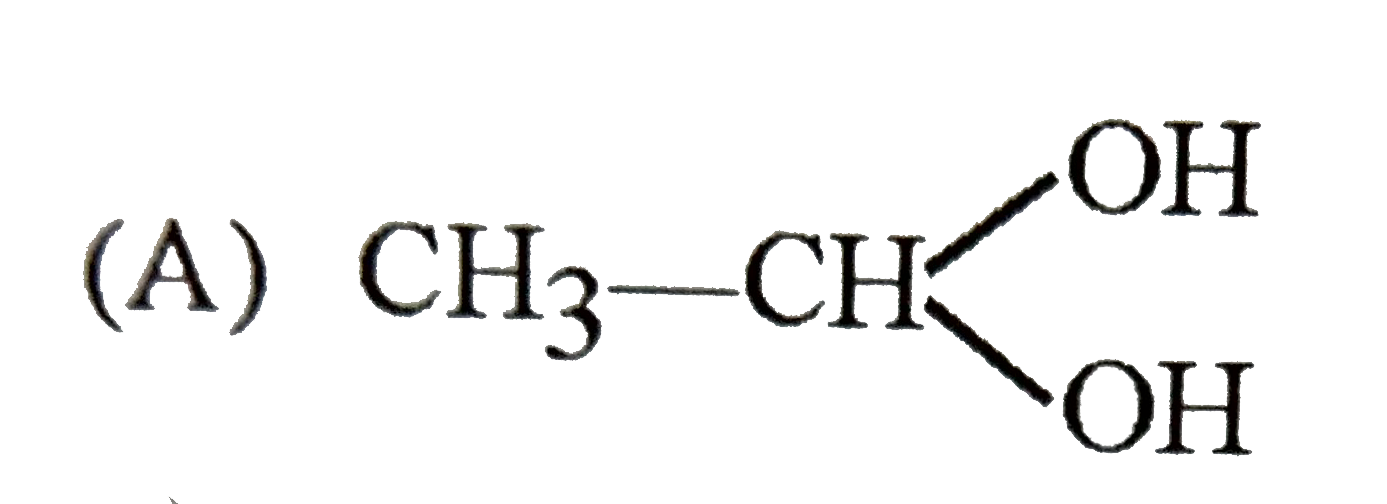A compound containing two-OH groups attached with same carbon dehydrates easily, but with which on of the following is its stable ?
CH3−
H3C−CH2−
Cl3C−
None of these
The correct Answer is:C
To solve the question regarding the stability of a compound with two -OH groups attached to the same carbon, we will analyze the factors affecting the stability of such compounds.
1. Understanding the Structure:
- The compound in question has two -OH (hydroxyl) groups attached to the same carbon atom. This structure is known as a geminal diol.
2. Dehydration of Geminal Diols:
- Geminal diols are known to dehydrate easily to form carbonyl compounds (C=O). This occurs because the presence of two hydroxyl groups on the same carbon creates significant repulsion between the lone pairs of electrons on the oxygen atoms.
3. Analyzing Stability Factors:
- When two -OH groups are present on the same carbon, the increased lone pair-lone pair (Lp-Lp) repulsion destabilizes the compound, leading to dehydration and the formation of a carbonyl compound.
4. Evaluating Different Substituents:
- We need to evaluate the stability of the geminal diol with different substituents:
- Case 1: CH3OHCH3: This compound will also dehydrate easily as there are no stabilizing factors.
- Case 2: C2H5OH: Similar reasoning applies; it will also dehydrate easily.
- Case 3: CCl3OH: The presence of chlorine, being highly electronegative, can lead to intramolecular hydrogen bonding. This bonding stabilizes the structure and reduces the tendency to dehydrate.
5. Conclusion:
- Among the options provided, the compound with the CCl3 substituent is the most stable due to the formation of intramolecular hydrogen bonds, which counteract the destabilizing effects of the two -OH groups.
Final Answer:
The compound with the CCl3 substituent is stable, making the correct answer C (CCl3).
- The compound in question has two -OH (hydroxyl) groups attached to the same carbon atom. This structure is known as a geminal diol.
- Geminal diols are known to dehydrate easily to form carbonyl compounds (C=O). This occurs because the presence of two hydroxyl groups on the same carbon creates significant repulsion between the lone pairs of electrons on the oxygen atoms.
- When two -OH groups are present on the same carbon, the increased lone pair-lone pair (Lp-Lp) repulsion destabilizes the compound, leading to dehydration and the formation of a carbonyl compound.
- We need to evaluate the stability of the geminal diol with different substituents:
- Case 1: CH3OHCH3: This compound will also dehydrate easily as there are no stabilizing factors.
- Case 2: C2H5OH: Similar reasoning applies; it will also dehydrate easily.
- Case 3: CCl3OH: The presence of chlorine, being highly electronegative, can lead to intramolecular hydrogen bonding. This bonding stabilizes the structure and reduces the tendency to dehydrate.
- Among the options provided, the compound with the CCl3 substituent is the most stable due to the formation of intramolecular hydrogen bonds, which counteract the destabilizing effects of the two -OH groups.
The compound with the CCl3 substituent is stable, making the correct answer C (CCl3).
Similar Questions
Knowledge Check
A compound containing two −OH groups attached with same carbon is unstable, but which one of the following is stable ?
A B
B C
C DNone
DNoneWhich of the following dehydrate easily ?
A3- methyl - 2 - butanolBEthyl alcoholC2- methyl propane - 2 -olD2- methyl butanol - 2Which of the following is thermally stable carbonate?
ALi2CO3BNa2CO3CBeCO3DCaCO3
When two halogen atoms are attached to same carbon atom then it is :
View SolutionThe compound which would give the most stable carbcation on dehydration is :
View SolutionAn unstable compound having two-OH groups on terminal carbon would immediately give a/ an
View SolutionA compound in which -OH directly attached to benzene ring is called
View SolutionThe compound which gives the most stable carbonium ion on dehydration is :
View Solution
